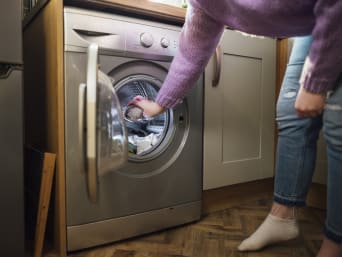Nature-friendly tips on how to wash your clothes
Each time you wash your clothes in the washing machine large amounts of water and electricity are consumed. In addition, lots of laundry detergents can release harmful substances into the environment and pollute it. To protect both your clothes and spare precious resources, you can follow a few simple tips on how to wash and save power. In this article you can find out more about how to wash your clothes in a more nature-conscious way.
Energy-efficient ways to wash clothes and choosing an alternative laundry detergent
Conventional laundry detergents usually consist of surfactants, phosphates, fragrances, preservatives and optical brighteners. Whilst washing your clothes all these substances end up in the wastewater which pollutes the environment, and they are also bad for your health.
Organic laundry detergents contain significantly fewer environmentally harmful ingredients, which are also often biodegradable. Phosphates and microplastics are usually not found in them. Unlike conventional laundry detergents, surfactants, soaps and water softeners are made out of vegetables or minerals.
However, it should be noted that even organic detergents cannot be completely labelled as ‘environmentally friendly’ - many still contain substances that pollute sewage treatment plants and natural bodies of water. Compared to conventional detergents, organic products with less harmful or even biodegradable ingredients can still be a step in the right direction.

When buying organic laundry detergents, make sure that they are labelled with the EU Ecolabel. This indicates that the product contains less environmentally harmful substances and that your clothes will be cleaned in the most natural way possible.
Comparing laundry detergents: liquid vs. powder detergents
There is a wide range of laundry detergents to choose from, such as washing powders and liquid laundry detergents. Washing pods are also a popular choice. In terms of cleaning effectiveness and environmental compatibility, there are some differences between the various types of laundry detergents. Below we have put together some helpful tips to help you choose the right detergent for a more nature-compatible wash:
Washing powder has the advantage that it does not contain any preservatives that are difficult to break down in comparison to liquid laundry detergent.
Powder washing detergents can be kept in cardboard packaging, which is biodegradable. Unfortunately, liquid laundry detergent and washing pods are generally in plastic packaging, which contributes to pollution.
Unlike liquid laundry detergent, powder detergent contains bleaching agents instead of optical brighteners. Therefore, powder laundry detergent cleans light coloured clothes more effectively.
You can also wash more effectively with a concentrated laundry detergent, because the high concentration means you need less laundry detergent to remove dirt.
What is modular laundry detergent?
A modular laundry detergent consists of a basic detergent, a water softener and bleach, which you can mix individually before washing. For example, if your clothes do not have stubborn stains, you can use less bleach and thus wash clothes more efficiently. Bleach is quite damaging for the environment, and it also pollutes water, therefore, it is a good idea to make sure that you don’t use too much. In addition, you shouldn’t use bleach on coloured or dark clothing.
How to use the correct amount of laundry detergent?
It’s important to use the right amount of laundry detergent so that you can wash your clothes and spare precious resources. Very dirty clothes will need more laundry detergent than clothes that are not very dirty or don’t have any stains. You can usually use the dosage guide on the packaging to help you get the right amount. This will reduce the amount of harmful substances that then get into the water. You can follow the basic guidelines below if you are still feeling unsure about how much laundry detergent you should use:
Slightly dirty; no visible stains and smell or maybe just a bit sweaty.
Not very dirty: if you have worn certain clothes a couple of times and any towels, bed linen and underwear that you have worn once also count as being dirty.
Very dirty: if your clothes have visible stains or have become very dirty. This often includes kitchen or dish towels, cleaning cloths, bibs or work uniforms.
Should you use fabric softener?
Fabric softeners make clothes soft and comfortable to wear and give them a nice scent. However, fabric softeners often contain surfactants, preservatives, fragrances and dyes that can be harmful to the environment. If you would like to wash your clothes in a way that is more compatible with nature, it is advisable to avoid fabric softeners or to use them very sparingly.
In the article linked below, we tell you how fabric softener affects different fibres and when it is advisable to use it:
The right washing programmes and detergents for clean laundry
How to load your washing machine to save resources
Doing laundry in a nature-compatible way also means washing less often. Don’t always wash your clothes straight away after just wearing them once. If they are not very sweaty or dirty, they often don't need to be washed. Instead, hang them on a hanger outside the wardrobe or on a clothes horse and leave to air out. The clothes will be fresh again and you can wear them another time.
In general, you should only put on a wash when the washing machine is full. Collect clothes of the same colour until the maximum load of the machine is reached. You can avoid unnecessarily consuming lots of water and electricity by always making sure your washing machine is full when putting on a wash.
You can also hand wash items of clothing. This may come in handy if you need a certain item of clothing, but you don’t have enough dirty laundry to put on a wash. Fill the sink or a washing bowl up with a little bit of water and add a little bit of laundry detergent. Hand washing single items uses less water than machine washing, no electricity and it is a lot gentler on delicate fabrics.

If you are not sure about how much laundry detergent you should use or the maximum drum load, you can weigh your laundry when it is dry. This way you know when the washing machine is full and also how much detergent you will need depending on how dirty your laundry is. However, on a gentle wash programme, don’t fully load the drum as you should usually only half or quarter fill it so that you can guarantee optimal washing results.
Power saving wash programmes and temperatures
A temperature of 30 to 40 degrees is generally sufficient for cleaning moderately soiled laundry and for saving energy while washing. Lots of laundry detergents nowadays can already work effectively at low temperatures and remove dirt completely. This will save about 35 - 40 percent of energy used. Only bed linen and towels should be washed at 60 degrees. In addition, washing at lower temperatures can leave germs in the washing machine, which you should remove once or twice a month by washing at 60 degrees.
In order to save power, make sure to choose the right washing machine programme. In the past, a pre-wash was often used to remove stubborn stains on clothes. Nowadays, you can skip the pre-wash because the detergents are more effective. By skipping this wash cycle you will save on water and electricity.
You should avoid short wash programmes if you would like to save electricity. The washing machine needs to reach a certain temperature much faster on a shorter wash programme, which increases energy consumption in comparison to longer wash programmes in eco mode.
You also don’t need to use a high spin cycle. The washing machine will consume less electricity with fewer revolutions during a wash. This also contributes to the longevity of your clothing.

Make sure that your washing machine offers eco modes. The eco mode will save energy whilst heating up the water in the machine. When buying a washing machine, you should always check the energy label.
Power-saving ways to dry clothes
Tumble dryers are now designed to use less energy whilst drying your clothes but leaving your clothes to dry on a clothes horse uses no electricity at all. Make sure to either leave your clothes to dry outside or in a well-ventilated room (e.g. in a dry and well-ventilated cellar or attic).
Drying your clothes in direct sunlight can make white clothes lighter, but it is recommended to dry darker-coloured clothes in the shade. Even on a cold dry day in the winter you can leave your washing outside to dry. If you can only dry your clothes indoors make sure to air frequently so that the room doesn’t become too damp, which can lead to mould.
Conclusion: use alternative washing detergents and energy efficient washing programmes for a nature-friendly approach
You can wash in a more nature-friendly way by using the correct amount of laundry detergent. Ideally, you should use laundry detergents that do not contain fillers or preservatives but can still clean your clothes effectively. It is also recommended not to use fabric softeners. By washing less frequently or only washing when the washing machine is full and doing the occasional hand wash, you can wash clothes in a more nature-conscious way. You can also save energy by leaving your clothes to dry either indoors or outdoors.
______________________________________________
References and further information:
https://blog.planetcare.org/zero-waste-laundry-guide/
(Last accessed on 09.04.2025)
https://learn.eartheasy.com/articles/7-ways-to-make-your-laundry-more-eco-friendly/
(Last accessed on 09.04.2025)
https://sustainabilitynook.com/environmentally-friendly-way-to-dry-clothes/
(Last accessed on 09.04.2025)
The image sources in this text are in chronological order:
Cover photo: iStock.com/Choreograph
1st image in text: iStock.com/Choreograph
2nd image in text: iStock.com/SimonSkafar
3rd image in text: iStock.com/SolStock










